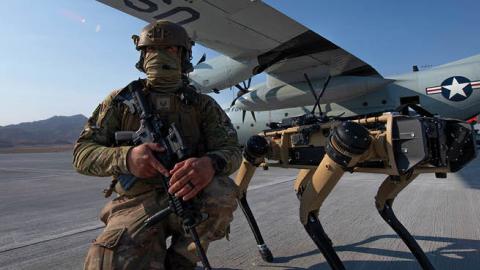Amazon founder Jeff Bezos famously attributes his company’s success to its customer obsession, which drove initiatives ranging from the creation of a cloud infrastructure and processing orders at unprecedented scale to establishing an entirely new logistics network that rapidly moves purchases to destinations. Amazon’s focus on shoppers is understandable, as it only makes about 1 percent of the merchandise it sells. Unlike a product-aligned business model like Apple’s, which seeks to anticipate or shape customer demand, Amazon’s bottom line depends on it being able to understand and respond to consumers better and faster than competitors.
Given the urgent challenges China and Russia pose to US allies, the US Department of Defense (DoD) should adopt a fulfillment model like that of Amazon. Although analysts often treat the DoD as a single customer in a monopsonistic relationship with its thousands of suppliers across the defense industrial base, the DoD more closely resembles a market where military services, combat support agencies, and defense contractors collaborate to deliver capabilities to their ultimate customers—combatant commands such as US Indo-Pacific Command (INDOPACOM), US Strategic Command (STRATCOM), and US European Command (EUCOM).
Viewing the DoD as a market rather than a customer suggests that services and agencies should focus their efforts on understanding and meeting combatant commanders’ needs. This would reverse the Pentagon’s longstanding practice, codified in the Joint Capabilities Integration and Development System (JCIDS), in which services and agencies predict future operational requirements and task government labs or contractors with developing solutions that will fill anticipated capability gaps.
JCIDS harkens back to the 20th century’s industrial model of product development exemplified by Henry Ford, who famously said that purchasers of his Model-T could have it in any color they wanted, as long as it was black. The DoD’s customers are similarly disenfranchised. The US Joint Staff, which administers JCIDS and acts as the combatant commanders’ representative in Pentagon decision fora, lacks acquisition authorities and funding and thus can impact defense programs only by defining requirements for future systems. Because requirements are predictive, they attempt to capture the full range of use cases for a new product, leading JCIDS to produce comprehensive, generalized solutions rather than customized capabilities designed to meet combatant commanders’ operational challenges.
The argument for military services “pushing” new systems to customers instead of letting end-users “pull” what they need centers on the perception that combatant commanders are focused on near-term capacity rather than next-generation capability. This assessment may have been valid in 2003 when JCIDS was first implemented. Emerging systems like the F-35 strike-fighter and DDG-1000 each took nearly two decades to reach fruition, and combatant commanders lacked the analytic processes and far-term perspective to determine what would be useful or feasible 10 to 20 years in the future. Moreover, the US military in 2003 was by far the world’s most capable force, and threats requiring substantially different US capabilities would take a decade or more to materialize.
However, the assumptions underlying the DoD’s industrial model of capability development are no longer valid. INDOPACOM assesses that China could mount a successful invasion of Taiwan during the 2020s, and Russia continues to threaten imminent action against Ukraine and NATO’s eastern members. Combatant commanders’ perspectives on capability requirements should therefore be a top priority for services, agencies, and the defense industry. At the same time, in the commercial sector, computing, manufacturing, and materials technologies are delivering new products within months or several years rather than decades. New defense industrial base entrants that leverage commercial advancements and software-centric innovation could quickly provide relevant capabilities by responding directly to combatant commander’s current and emerging operational challenges.
Unfortunately, the DoD’s pursuit of efficiency and centralized decision-making hinder the direct connections between combatant commander customers and commercial or government suppliers that foster innovation. The results will therefore continue to be one-size-fits-all solutions that take longer and are more expensive than concepts and capabilities tailored to meet specific needs. In addition to furthering the Pentagon’s well-documented problems delivering new systems and concepts on cost and schedule, universal solutions will be less likely to target the specific threats posed by such peer adversaries as China or Russia.
Without restoring combatant commander customers to the center of the DoD’s capability development efforts, US forces will not be able to keep up with the challenges posed by peer adversaries like China or Russia and may even find themselves behind regional powers with geographic advantages and little to lose. The US military cannot afford another failed and ponderous attempt to “boil the ocean” with universal solutions and should take a page from Amazon by focusing on customer needs first.



















